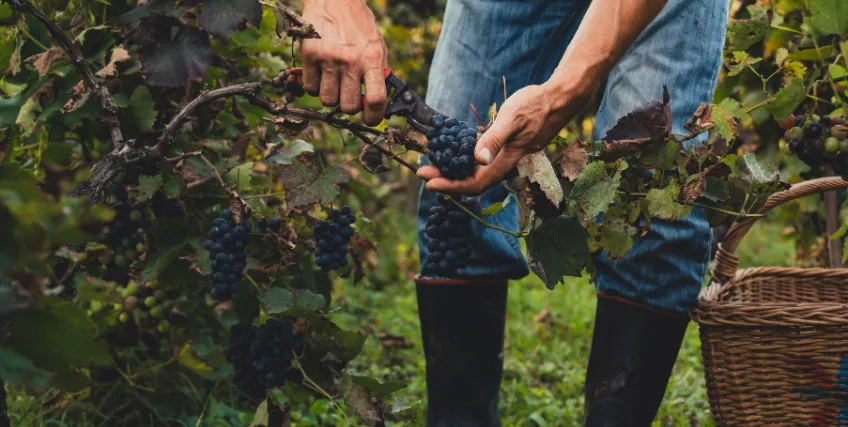Popular Financing Options for Starting Your Own Vineyard
Sep 23, 2025 | Last Updated on: Sep 24, 2025

Vineyards are expensive, take years to become profitable, and require significant upfront investment. Land, vines, equipment, and skilled labor all come at a high cost, which is why vineyard and winery financing isn’t optional — it’s a necessity.
Finding vineyard loans isn’t necessarily easy, either. While vineyard financing is certainly available, you’ll need more than just passion to get approved. You may have several loan options available, from traditional bank loans to specialized government programs, but you’ll need to know how to navigate the process if you’re going to succeed.
In this article:
- Understand the significant upfront costs of starting a vineyard and the winery funding options available.
- Explore a range of vineyard loans, from conventional to specialized government-backed lending programs.
- Learn how to qualify for popular financing solutions and increase your chances of credit approval.
The Costs of Starting a Vineyard
Before you can even think about financial services or a business loan, you must have a comprehensive understanding of your startup costs. Like any business owner, before you get into your winery funding options, it’s crucial to have a realistic and detailed budget so you know exactly how much money you need. Not only will that help you land on a loan amount to apply for, but it can inform the type of vineyard loan product you pursue.
Some of the costs to consider include:
- Land acquisition: Vineyards have some unique needs, including a specific tract of land. Grapes don’t thrive everywhere. You’ll likely need a farm loan or real estate loan to get land suitable for viticulture. Finding the right terroir is essential, and the price tag can be substantial.
- Site preparation: Vineyard development is a multi-year investment that includes site preparation, planting the vines, establishing trellises, and installing irrigation. It will take years of caring for your vine before you produce a harvest. This requires major operating expenses before you even see a dime from your work.
- Equipment and infrastructure: Like any agricultural business, a vineyard requires specialized machinery like tractors, sprayers, and harvesters. But it also requires winemaking equipment and renovations to support the business, like a tasting room, production facility, and wine cellar. Vineyard loans can help you cover all of these costs.
- Operational and working capital: A vineyard has an unusual cash flow cycle. It can take years before a newly planted vine produces its first viable crop and even longer to recoup your initial investment. During these lean years, you’ll need funding to cover labor, maintenance, taxes, insurance, and marketing. Vineyard loans can help.
Types of Vineyard Loans and Financing Options
The agricultural industry has access to a host of farm loans as well as traditional financing solutions. Agricultural lending can tailor products to the long-term, capital-intensive nature of farming. These are some of the most popular options to explore.
Agricultural Loans (Farm Credit System)
The Farm Credit System is a nationwide network of borrower-owned lending institutions, kind of like a credit union system for the agricultural industry. It’s likely the most specialized and knowledgeable source of vineyard loans you’ll find. These institutions understand the unique challenges of farming and the long-term investment cycles of vineyards.
Lenders in the Farm Credit System have a deep understanding of the agricultural sector, including viticulture, and can assess the viability of your business plan in a way that a commercial bank might not. These loans tend to offer long repayment terms and competitive interest rates that are often lower than traditional loans, and have flexible repayment schedules that align with the seasonal nature of a vineyard’s cash flow.
They can be great vineyard loans for new farmers, but they can be difficult to qualify for. The application and approval process tends to be lengthy and paperwork-intensive. You’ll need a strong financial history, a solid business plan, and usually significant collateral that often includes the land itself.
Nonetheless, these vineyard loans are often the top choice for a serious, long-term investment due to their tailored nature and favorable terms.
Term Loans
Term loans are straightforward loans in which a lender provides a lump sum of money, and you repay it over time with regular, fixed payments. The predictable nature of term loans makes it easy to budget and forecast expenses over the life of the loan, and you can generally use a term loan for a wide variety of purposes. That allows you to check off boxes like purchasing equipment, building a tasting room, or covering operational costs all with the same loan.
However, term loans tend to have shorter repayment schedules than specialized agricultural loans and will likely have less flexible repayment options. Online lenders may be more willing to offer specialized vineyard loans than traditional banks, but often at the cost of higher interest rates.
Equipment Financing
Equipment financing is a great, targeted option for the expensive machinery and winemaking equipment you will need. In this type of financing, the farm equipment itself serves as collateral for the loan.
Given how much equipment you need on a vineyard, equipment loans are a useful way to acquire what you need at a much lower upfront cost, so you can preserve your working capital for other needs. These useful vineyard loans can help you gear up to start growing, harvesting, and processing grapes.
Government-Backed Loans
The U.S. Small Business Administration (SBA) and the U.S. Department of Agriculture (USDA) offer various government-backed loan programs that are a lifeline for many rural businesses, including vineyards. These loans often have lower interest rates and longer repayment terms for qualified applicants.
These loans can be very versatile. SBA loans like the SBA 7(a) loan can be used for almost anything, from real estate to working capital, while the USDA Farm Service Agency (FSA) offers a range of loans for land acquisition, business growth, and more.
Government-backed loans offer some of the best terms, but they also have the longest process. They require you to meet stringent eligibility criteria and the application process is famously detailed and time-consuming. Nonetheless, if you’re willing to invest the necessary time and energy, these vineyard loans can provide the most favorable terms available.
Business Lines of Credit
A business line of credit is a more accessible financing solution than many loans. With a line of credit, you’re approved for a maximum credit line that you can draw from as needed. You only pay interest on what you draw, and when you repay the borrowed amount, you have access to the full credit amount again.
A line of credit can serve as a vital financial safety net during periods of slow cash flow, after financial emergencies, or when you have a sudden business opportunity.
How to Improve Your Vineyard Loans Eligibility
Getting approved for a vineyard loan likely won’t happen overnight. Even online lenders with outstanding funding times may need a little time to consider lending to such a unique business. These tips can give your application the best chance of success:
- Take time with your business plan: Your business plan could very well make the difference between success and failure. This professional document should show lenders you have a deep understanding of the industry, your market, your financial projections, and how you will manage the long lead time to profitability. Take the time to create detailed budgets for land, planting, equipment, and operations, and always highlight your expertise. If you have experience in winemaking, viticulture, farming, or business management, emphasize it.
- Get your finances in order: Before applying, gather all your personal financial documents, including tax returns, bank statements, and a detailed list of assets and liabilities. Getting organized can help expedite the process.
- Get your credit in order: Before applying for a loan, check your credit report for errors and ensure you have an up-to-date picture of your credit score. Bad credit doesn’t necessarily mean you’ll be denied, but you likely won’t get the best interest rates available. Taking time to improve your credit score before applying could save you thousands in interest down the line.
- Have a clear use of funds: Don't just say you need money for "startup costs." Be specific about how every dollar of the loan will be used. A lender needs to see a detailed breakdown of how the funds will directly contribute to your business's success and ability to repay the loan.
- Manage seasonal cash flow: Getting approved for vineyard loans demands that you have a plan to manage the seasonal, prolonged cash flow cycles of a vineyard. A key challenge for a vineyard is the seasonal nature of revenue. Lenders will want to see that you have a plan to manage cash flow through the off-season. This could include a line of credit or other contingency plans.
Final Thoughts
Starting a vineyard is a herculean undertaking, but with the right financial strategy, it might just be achievable. Take the time to carefully assess your needs and explore the various vineyard loans available on the market. With the right winery financing, an aspiring vineyard owner can start laying down roots and cultivating a business to be proud of for years to come.
FAQs About Vineyard Loans
How long does it take to secure a loan for a vineyard?
It depends on the type of loan and lender. Equipment financing or a small term loan could be approved quickly. Large agricultural loans or government-backed loans can take several months.
Can I get a loan if I have no prior experience in viticulture?
It’s difficult but not impossible. Lenders will put a high value on your business plan, financial projections, and your team’s expertise. You’ll likely need an experienced winemaker, viticulturist, or business manager as a partner to show you’re serious.
What is the difference between an agricultural loan and a traditional term loan?
An agricultural loan is specifically designed for farming businesses. Lenders in this space have a better understanding of the unique seasonal cycles and risks of agriculture, often offering more flexible repayment terms and longer amortization periods than a traditional bank.
Do I need to provide collateral for a vineyard loan?
Almost all significant vineyard loans will require collateral. The most common form of collateral is the vineyard land itself. Lenders need a way to mitigate their risk, especially given the large capital investment and long timeline to profitability.
How much of a down payment should I expect to make on a vineyard loan?
Down payment requirements vary, but it’s often substantial for a large-scale project.
Frequent searches leading to this page
Term Loans are made by Itria Ventures LLC or Cross River Bank, Member FDIC. This is not a deposit product. California residents: Itria Ventures LLC is licensed by the Department of Financial Protection and Innovation. Loans are made or arranged pursuant to California Financing Law License # 60DBO-35839




